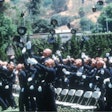I've written repeatedly that your signature as an officer is more than likely the quality of your written reports. Even heroics need to be documented. All of the technology has taken away some errors but the substance must be there. Have you stepped back and actually re-read your report as a reader and not the writer? Do it sometime for a eyebrow-raising event.
Technology has taken us a long way. I don't know what kind of police records system you use. Most have spell-check, some have grammar checks, and the pre-populated fields are a time saver. Despite the technological advances, these reports still depend on human input.
There's nothing that warms the cockles of my heart like a chronologically paced and descriptive police report. Trust me, after years of reading these, the good ones stand out. I mention chronologically written report for a reason. A classic rookie mistake is to write the cool stuff first, because it's exciting. The report must reveal the sequence of events as it revealed itself to you and how you positioned your response to this great arrest.
Descriptive writing is a lost art. When I was in the military, there was a basic way to describe anything — M1 widget, hand-held, air-cooled, OD green in color. Some of the best report writers seek balance between excellent descriptive language and novelistic writing.
However, I had one report of where a young officer took literary license a tad too far. He changed his title and role in the report along with the citizen's role, which raised the question of how many people were involved in the incident.
He referred to the dispatched officer, the primary officer, the investigating officer, the reporting officer, the arresting officer, the transporting officer, and the booking officer. And the citizen became the complainant, the alleged victim, the suspect, the person of interest, the perpetrator, the detainee, the arrestee, and then the transported prisoner. Whew!
As I read the report of a false report of a crime I kept counting the number of persons in this report. There were two, one bad guy and one copper with far too much time on their hands.
Ownership affects your point of view as a proofreader. Nobody likes being corrected. I have a proofer for my work, and then editors. Their job is to correct my errors and make the product palatable for the readers or the end user's needs. So I get a rewrite or see occasional red ink; the goal here is not to protect my feelings, but rather communicate succinctly with you as a reader.
As a police report writer, aim for your end users. It's not the sergeant, but the entire criminal justice system (from detectives to the prosecuting attorney) and externals (such as insurance companies, the media, and corrections personnel).
Once you have labored over a lengthy report, stop if you can. Grab a coffee, sit back down and read it as a neutral party, from the 10,000-foot level. Try to disassociate yourself from your product and read it critically. Don't give it a quick blush over; read it.
For me, I must read aloud to hear it, sounds weird, try it once. The biggest problem is that we as police investigative report writers take pride but short cuts. In the old days, a rewrite meant a rewrite. Now with the work station, edits require only a few key strokes.
Take pride in your work, but give it a thorough once over before you send it up the flagpole.
Related:


















